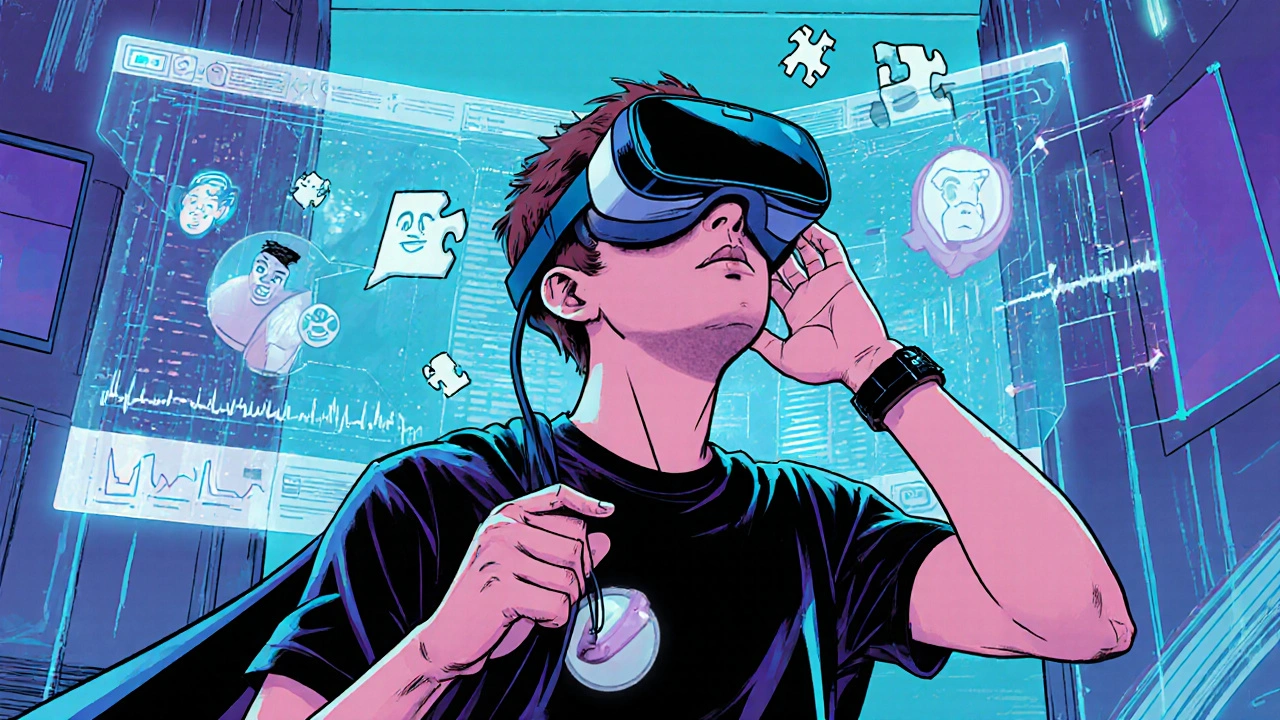
Digital Therapy Selection Tool
Select Your Scenario
This tool helps identify the most appropriate digital therapy modalities for specific behavioral disorders and situations.
When we talk about technology in the treatment of behavior disorders, we’re looking at a wave of digital tools that help clinicians, families, and patients manage conditions like ADHD, autism spectrum disorder, and conduct disorder more effectively.
Key Takeaways
- Teletherapy and mobile apps have expanded access to evidence‑based therapies.
- Wearable sensors and AI‑driven assessments provide real‑time data on behavior patterns.
- Virtual reality (VR) and neurofeedback are emerging as immersive treatment options.
- Privacy, data security, and clinician training remain critical challenges.
- Future developments point toward personalized, adaptive digital therapeutics.
Understanding Behavior Disorders
Behavior disorders are mental‑health conditions characterized by persistent patterns of harmful or disruptive actions. Common types include attention‑deficit/hyperactivity disorder (ADHD), oppositional defiant disorder (ODD), and autism spectrum disorder (ASD). These conditions often interfere with school, work, and relationships, and traditional treatment relies on medication, behavioral therapy, and parent training.
How Technology Is Changing Treatment
Technology in the treatment of behavior disorders is the application of digital platforms-such as mobile apps, telehealth services, and sensor‑based monitoring-to support diagnosis, intervention, and ongoing management of behavioral health conditions. By delivering therapy outside the clinic, providing objective data, and creating engaging therapeutic experiences, tech tools are reshaping the care pathway from assessment to long‑term follow‑up.

Major Technology Tools
Below are the most widely adopted digital solutions, each with a brief definition and real‑world example.
Teletherapy
Teletherapy is the remote delivery of mental‑health services via video conferencing platforms, allowing clinicians to conduct sessions with patients in their homes. During the pandemic, platforms like Zoom for Healthcare and specialized services such as BetterHelp saw a 300% rise in usage for ADHD coaching and CBT for conduct disorder.
Mobile Apps
Mobile mental‑health apps are software applications for smartphones that provide tools like mood tracking, skill‑building exercises, and reminder systems for medication adherence. Apps such as Calm, Headspace, and the FDA‑cleared EndeavorRx (designed for ADHD) have demonstrated measurable improvements in attention span after eight weeks of regular use.
Wearable Sensors
Wearable sensors are devices that monitor physiological signals-heart rate, skin conductance, movement-and translate them into behavioral insights. Companies like Empatica and Biostrap offer wristbands that alert caregivers when a child with ODD shows signs of escalating agitation, enabling timely de‑escalation strategies.
Artificial Intelligence Assessment
AI‑driven assessment tools are software that applies machine‑learning algorithms to video, audio, and sensor data to identify patterns indicative of specific behavior disorders. A 2024 study from Stanford showed that an AI model analyzing facial expressions and speech cadence could differentiate between ASD and typical development with 92% accuracy.
Virtual Reality (VR)
Virtual reality therapy is an immersive, computer‑generated environment used to practice social skills, emotion regulation, and exposure therapy. Programs like Floreo and Oxford VR have reported that children with ASD improve eye‑contact and turn‑taking after only ten 20‑minute VR sessions.
Neurofeedback
Neurofeedback is a biofeedback technique where real‑time brain‑wave data is displayed to the user, who learns to self‑regulate neural activity. FDA‑cleared devices such as MyndMind are being piloted in UK schools to help students with ADHD improve focus during lessons.
Comparison of Key Tech Modalities
| Modality | Primary Use | Evidence Level (2024‑2025) | Typical Cost (per month) | Best Fit For |
|---|---|---|---|---|
| Teletherapy | Remote CBT, parent coaching | Strong - RCTs show 30% symptom reduction | £40‑£80 | Families in rural areas |
| Mobile Apps | Skill practice, habit tracking | Moderate - Meta‑analyses show small‑to‑moderate effect | Free‑£15 | Tech‑savvy teens |
| Wearable Sensors | Real‑time agitation monitoring | Emerging - pilot studies show 20% faster response | £30‑£60 | Children with ODD or severe anxiety |
| AI Assessment | Diagnostic support, risk scoring | Promising - 90%+ accuracy in early trials | Enterprise pricing | Clinics seeking objective data |
| VR Therapy | Social skills, exposure | Strong - controlled trials show 25% improvement in social interaction | £100‑£200 (equipment) | Older children and adolescents |
| Neurofeedback | Self‑regulation of attention | Mixed - some RCTs report significant gains | £150‑£300 (session series) | Students with ADHD in school settings |
Implementing Technology in Clinical Practice
- Assess patient needs: Determine which disorder features (e.g., attention deficits, social anxiety) align with a specific tech tool.
- Choose evidence‑based platforms: Look for FDA clearance, NHS endorsement, or peer‑reviewed validation studies.
- Integrate with existing therapy: Use teletherapy for weekly check‑ins, supplement with a mobile app for daily exercises, and add wearables for objective monitoring.
- Train staff and families: Provide short onboarding videos and step‑by‑step guides; ensure they understand data sharing permissions.
- Monitor outcomes: Track symptom scales (e.g., Conners’ Rating Scale for ADHD) alongside digital metrics like usage time or physiological alerts.
- Iterate and adjust: If a tool shows low engagement, switch to an alternative that better matches the patient’s preferences.

Risks, Ethics, and Data Privacy
Digital interventions bring convenience, but they also raise concerns. Data collected by wearables or AI platforms can be highly sensitive. In the UK, the GDPR and NHS Digital standards require explicit consent, clear data‑retention policies, and encryption at rest and in transit.
Another ethical issue is algorithmic bias. AI models trained on predominantly Western datasets may misclassify behavior patterns in multicultural populations. Clinicians should verify that any AI tool provides transparency about its training data and offers a human‑in‑the‑loop review.
Finally, over‑reliance on apps can undermine face‑to‑face interaction. The best practice is to view technology as an adjunct-not a replacement-for therapeutic rapport.
Future Trends to Watch
- Personalized digital therapeutics: Machine‑learning algorithms will tailor intervention intensity based on real‑time feedback.
- Hybrid care models: Integrated platforms that combine teletherapy, AI diagnostics, and electronic health records will streamline care pathways.
- Gamified neurofeedback: Game‑engine graphics will make brain‑training more engaging for children.
- Regulatory harmonization: The UK Health and Care Act is expected to introduce a dedicated “digital therapeutics” approval pathway by 2026.
Frequently Asked Questions
Can teletherapy replace in‑person therapy for behavior disorders?
Teletherapy works well for delivering CBT, parent coaching, and medication management, but it usually complements rather than fully replaces in‑person sessions, especially when hands‑on observation or physical activities are needed.
Are mobile apps safe for children with ADHD?
Most reputable apps comply with data‑privacy standards and have been tested in clinical trials. Parents should verify age ratings, read privacy policies, and choose apps with clear evidence of efficacy, such as EndeavorRx.
How accurate are AI diagnostic tools for autism?
Recent AI models achieve up to 92% accuracy in distinguishing autism from typical development when fed high‑quality video and audio data. However, they should be used as a screening aid, not a definitive diagnosis.
Do wearables really help prevent meltdowns?
Studies show that real‑time physiological alerts can reduce the duration of meltdowns by about 20% because caregivers intervene earlier. Success hinges on consistent wear and clear response protocols.
What privacy safeguards should I look for?
Choose platforms that encrypt data end‑to‑end, store information on GDPR‑compliant servers, and provide transparent consent forms. Look for certifications like ISO/IEC 27001 or NHS Digital’s ‘Trusted Health’ badge.
Allan Jovero
September 23, 2025 AT 14:23It is imperative to acknowledge that the integration of digital therapeutics into behavioral health must be guided by rigorous evidence and unwavering clinical oversight. The literature consistently demonstrates that teletherapy, when delivered by qualified professionals, yields statistically significant reductions in symptomatology for ADHD and related disorders. Moreover, any claim suggesting that technology alone can supplant traditional modalities is fundamentally flawed. Consequently, policymakers should mandate certification pathways for all digital health applications. Finally, adherence to data‑privacy regulations such as GDPR remains non‑negotiable.
Andy V
September 30, 2025 AT 13:03The prevalence of poorly vetted apps on the market is a glaring omission in many practitioners' oversight duties. One must scrutinise each platform's methodology before recommending it to vulnerable populations. Inadequate validation leads to wasted resources and potential harm. Therefore, a systematic review of digital tools should become a standard practice in clinical settings.
Sen Đá
October 7, 2025 AT 11:43The recent surge in artificial‑intelligence‑driven assessments heralds a notable advancement in early detection of autism spectrum disorder. Empirical studies from 2024 have reported diagnostic accuracies surpassing 90 % when facial and vocal analyses are combined. Nevertheless, these algorithms are typically trained on homogeneous datasets, which raises concerns regarding cross‑cultural applicability. Clinicians are advised to corroborate AI‑generated scores with comprehensive behavioural evaluations. Integration of such tools should therefore be pursued with caution, ensuring that informed consent and data‑security protocols are meticulously observed.
LEE DM
October 13, 2025 AT 06:37Building on that, it’s crucial we keep the conversation inclusive and ensure that families from diverse backgrounds feel supported when navigating these tech options. Simple, culturally‑sensitive guides can make a big difference.
Amy Aims
October 18, 2025 AT 11:37Love seeing how VR therapy is making social skills practice fun for kids! 😊 Keep the innovations coming.
Shaik Basha
October 23, 2025 AT 02:43Yo, those VR games are legit cool but u gotta make sure they don't break the bank. Some fams prob cant afford the headset lol.
Michael Ieradi
October 27, 2025 AT 02:57Providing clear, step‑by‑step onboarding materials is essential; it reduces friction and improves adherence.
Stephanie Zuidervliet
October 30, 2025 AT 14:17And yet, many platforms launch without any tutorial-leaving users in the dark!! It's maddening!!!
Olivia Crowe
November 2, 2025 AT 11:43Digital tools are awesome when paired with human support.
Aayush Shastri
November 4, 2025 AT 19:17Absolutely! In my experience, a blend of teletherapy and a well‑chosen app keeps engagement high, especially for teens from multicultural families.
Dominique Jacobs
November 6, 2025 AT 12:57Alright folks, let’s dive deep into why the hype around digital therapeutics isn’t just a passing fad. First, the accessibility factor is a game‑changer-kids in remote villages can now tap into evidence‑based CBT via video calls, something unimaginable a decade ago. Second, the data‑rich environment of wearables offers real‑time insights, letting clinicians intervene before a full‑blown crisis erupts. Third, the engagement boost from gamified neurofeedback keeps children glued to the therapy rather than dreading it. Fourth, the cost landscape is shifting; many apps operate on freemium models, lowering the barrier to entry for low‑income families. Fifth, regulatory bodies are finally catching up, with the UK Health and Care Act paving the way for a formal digital therapeutics approval pathway by 2026. Sixth, interdisciplinary collaborations are sprouting, merging expertise from psychiatry, computer science, and education to craft holistic solutions. Seventh, the pandemic forced an accelerated adoption, and the lessons learned are now being codified into best‑practice guidelines. Eighth, clinicians report higher satisfaction when they can supplement in‑person sessions with tech tools, citing reduced no‑show rates. Ninth, parental empowerment has surged; dashboards let caregivers monitor progress without invasive questioning. Tenth, the scalability of AI‑driven assessments means early screening can be rolled out in schools en masse, catching at‑risk children sooner. Eleventh, we’re seeing a cultural shift where mental health tech is no longer stigmatized but celebrated as cutting‑edge care. Twelfth, long‑term outcome studies are beginning to show sustained improvements in attention spans and social interaction metrics. Thirteenth, interoperability with electronic health records ensures that digital data feeds directly into the patient’s medical history. Fourteenth, emerging research on adaptive algorithms promises to personalize treatment intensity dynamically. Fifteenth, the community feedback loops-think user forums and co‑design sessions-are refining the user experience continuously. In short, the convergence of accessibility, data, cost, regulation, and community involvement makes digital therapeutics a robust pillar of modern behavioral health.
Dawn Mich
November 7, 2025 AT 22:17Sure, the tech wave looks promising, but remember every algorithm is built on data that may be compromised. Big Pharma and tech giants are quietly colluding to monetize every click and symptom report. If you’re not vigilant, you’ll hand over your child’s biometric signatures to entities that could weaponize them for profit. Trust no platform without demanding full transparency about data pipelines.
Eric Sevigny
November 9, 2025 AT 02:03Just wanted to add that for families on a tight budget, many open‑source mobile apps provide solid CBT exercises. I’ve seen good results when combined with weekly check‑ins via low‑cost teleconference services. Keep an eye out for community‑driven resources-they’re often overlooked.
Glenda Rosa
November 10, 2025 AT 00:17While everyone lauds the “miracle” of AI diagnostics, let’s not forget that most of these systems are trained on privileged datasets. Their dazzling 92 % accuracy evaporates when applied to under‑represented groups. In reality, they risk reinforcing existing disparities under the guise of scientific progress.
Francisco Garcia
November 10, 2025 AT 19:43I’m curious about how cultural nuances are incorporated into VR therapy scenarios. If the avatars and social scripts don’t reflect diverse backgrounds, the efficacy could be limited. Developers should engage community advisors early on.
Patrick Renneker
November 11, 2025 AT 12:23It is a common misconception that the mere presence of immersive technology guarantees therapeutic benefit. One must consider, with meticulous scrutiny, the heterogeneity of patient response profiles, the potential for sensory overload, and the necessity of rigorous longitudinal studies to substantiate efficacy claims; otherwise, we risk promulgating premature enthusiasm that may inadvertently compromise clinical standards.
KAYLEE MCDONALD
November 12, 2025 AT 02:17Supporting families with clear, concise guidance makes all the difference.
Aaron Perez
November 12, 2025 AT 13:23Consider the epistemological implications of outsourcing assessment to algorithms; we risk surrendering agency to opaque black boxes, thereby undermining the very foundation of patient‑centered care.